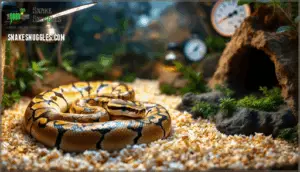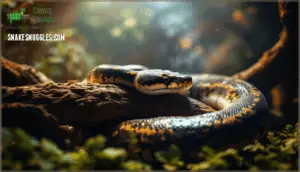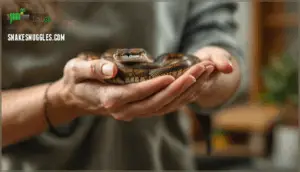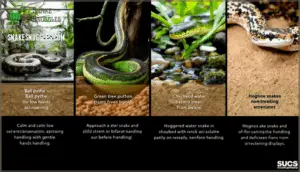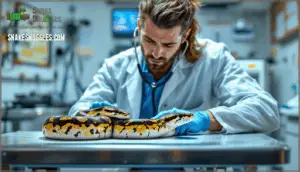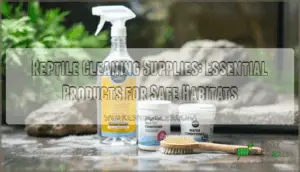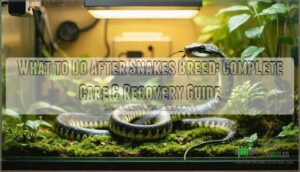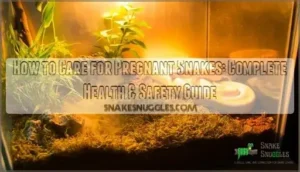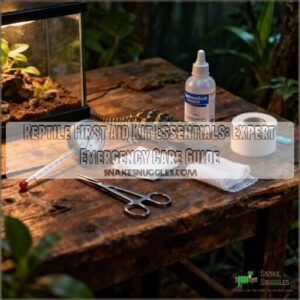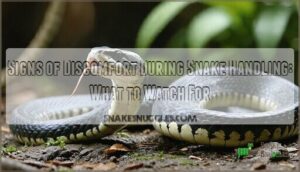This site is supported by our readers. We may earn a commission, at no cost to you, if you purchase through links.
 You’ve just watched your snake consume its prey, and now the real work begins. What happens in the next 48 hours can mean the difference between healthy digestion and a dangerous regurgitation episode that threatens your snake’s health.
You’ve just watched your snake consume its prey, and now the real work begins. What happens in the next 48 hours can mean the difference between healthy digestion and a dangerous regurgitation episode that threatens your snake’s health.
A snake’s metabolism spikes up to tenfold after eating, creating a critical window where temperature, humidity, and interaction decisions directly impact digestion success. Many snake owners unknowingly sabotage this process by cleaning enclosures, adjusting temperatures, or picking up their pets too soon.
Understanding proper post-feeding care protects your snake from esophageal damage, dehydration, and the compounding health risks that follow each regurgitation incident.
Table Of Contents
Key Takeaways
- Wait at least 48 hours before handling your snake after it eats, as disturbing it during this period can trigger regurgitation that damages the esophagus and causes dehydration.
- Maintain stable temperatures between 25°C and 30°C and proper humidity levels after feeding, since your snake’s metabolism spikes up to tenfold and requires optimal conditions for efficient digestion.
- Watch for warning signs like regurgitation of undigested food with mucus, excessive lethargy, throat swelling, or repeated meal refusal, which indicate you need to consult a reptile veterinarian.
- Avoid cleaning the enclosure, adjusting temperatures, or rearranging the habitat immediately after feeding, as these disturbances increase stress and regurgitation risk during the critical digestion window.
What to Do After Your Snake Eats
Once your snake finishes eating, the real work begins. Your actions in the hours and days following a meal can make the difference between healthy digestion and serious complications.
Let’s walk through the essential steps you need to take to keep your snake safe and comfortable after feeding time.
Why Post-Feeding Care Matters
Understanding post-feeding care matters because your snake’s digestion process triggers dramatic metabolic changes. After eating, metabolic rates can spike up to tenfold, peaking within the first few days. This surge demands proper hydration and stable temperatures for digestion efficiency.
Poor snake care during this critical window increases regurgitation risk, which can damage your snake’s health. Long-term health depends on respecting your snake’s physiology during digestion, when snake behavior shifts and snake nutrition needs intensify.
Critically ill snakes may require assisted feeding to help them receive adequate nutrition.
Immediate Steps After Feeding
Once you’ve witnessed your snake swallow its prey, your next moves can make the difference between smooth digestion and a stressful setback. First, leave your snake alone—no touching for at least 48 hours. Check the enclosure temperature and humidity to support the digestion process.
Observe from outside the tank, noting prey type and food size. Avoid cleaning or rearranging during this observation period, as disturbances trigger regurgitation and disrupt snake behavior.
How Long to Wait Before Handling
You might wonder when it’s safe to pick up your snake again, and the answer depends on prey size, species, and how well your pet digests its meal. As a general rule, wait 48 hours minimum, though larger meals require up to a week. Rushing the waiting period increases regurgitation risk and disrupts the digestion process.
Monitor snake behavior for signs of complete digestion, like increased activity, before resuming interaction after eating.
Preventing Regurgitation and Stress
When your snake finishes a meal, what happens next matters just as much as the feeding itself. The hours and days following digestion are when your pet is most vulnerable to complications.
Let’s look at the key risks you need to watch for and how to keep your snake comfortable during this critical window.
Risks of Handling Too Soon
Handling a snake too soon after it eats is like shaking a full soda bottle—you’re asking for trouble. When you disturb your snake during the digestion process, the stress impact and physical jostling can trigger regurgitation, which carries serious handling consequences:
Handling your snake too soon after feeding can trigger regurgitation, causing esophageal damage and serious health complications
- Esophageal damage from bringing up partially digested prey can leave lasting tissue trauma.
- Dehydration risks increase considerably when nutrients are expelled before absorption.
- Regurgitation dangers compound with each incident, weakening your snake’s overall health.
- Handling frequency directly affects regurgitation risk, especially within 48 hours post-feeding.
The snake window matters more than most owners realize; dealing with after feeding can cause undue stress.
Recognizing Signs of Regurgitation
If your snake suddenly brings up its meal, knowing what you’re looking at can mean the difference between a quick recovery and a serious health crisis. Watch for undigested food with a mucus coating, which signals an interrupted digestion process. Behavioral changes like lethargy often follow, alongside dehydration risks and potential weight loss.
Regurgitation risk increases with improper snake restraint during the vulnerable post-feeding window.
| Sign | What to Look For | Severity |
|---|---|---|
| Undigested Food | Whole or partially broken-down prey with mucus | High |
| Esophageal Damage | Visible throat swelling, refusal to eat | Critical |
| Behavioral Changes | Hiding excessively, reduced activity | Moderate |
| Dehydration Risks | Sunken eyes, loose skin | High |
Stress Factors to Avoid
Even minor disturbances during your snake’s post-feeding period can trigger stress responses that derail digestion and compromise its health. Interaction frequency should drop to zero for at least 48 hours, allowing the digestion process to proceed without interruption. Environmental enrichment like sudden enclosure rearrangements can disrupt animal behavior patterns and delay nutrient absorption.
Key stress factors that compromise animal welfare:
- Excessive interaction frequency interferes with the snake’s natural digestion process and increases regurgitation risk
- Poor enclosure security creates anxiety as snakes feel vulnerable during their post-feeding metabolic state
- Dietary changes or social interaction during digestion disrupts established animal behavior patterns and metabolic efficiency
Optimizing Snake Digestion and Health
After your snake eats, the environment you provide plays an important role in digestion. Getting the temperature, humidity, and hydration right can make the difference between smooth digestion and potential problems.
Here’s what you need to focus on to keep your snake healthy during this important period.
Temperature and Humidity Requirements
Your snake’s enclosure setup needs precise control of ideal temperatures and humidity levels to support digestion rates after feeding. Most species digest best between 25°C and 30°C, but species variation matters—ball pythons need different conditions than corn snakes.
Proper reptile enclosures and housing maintain these parameters, directly affecting reptile health and nutrition and digestion. Getting your reptile care environment right isn’t optional; it’s what keeps your snake processing meals safely without complications.
Hydration and Its Impact on Digestion
Dehydration complicates your snake’s digestion, slowing everything down and creating complications you don’t want to deal with. Hydration levels directly affect digestion efficiency—dehydrated snakes lower their preferred body temperature by 1.1 to 1.5°C, which extends digestion time considerably.
You’ll notice this impacts shedding and overall reptile nutrition and digestion. Keep fresh water available and maintain proper temperature control to support healthy animal behavior and welfare.
Monitoring Post-Feeding Behavior
After your snake finishes its meal, watching how it behaves tells you everything you need to know about whether digestion is proceeding normally. Look for reduced activity levels and a preference for warm spots, which indicate healthy digestion time. Note any shedding patterns or weight fluctuations, as these reflect reptile nutrition and digestion success.
Understanding snake behavior and body language helps you determine appropriate interaction frequency while supporting animal behavior and welfare throughout the digestion observation period.
Safe Snake Handling Practices
Picking up your snake at the right time and in the right way makes a big difference in keeping both of you safe and stress-free. The techniques you use and the timing you choose depend partly on your snake’s species and individual temperament.
Let’s look at the best practices for confident, calm picking up that won’t upset your snake’s routine.
Best Times to Handle Your Snake
You can’t just grab your snake anytime you feel like it—timing is everything if you want to keep both of you safe and comfortable. Wait at least 48 hours after feeding to allow proper digestion time, though some snake species need longer depending on prey size and individual temperament.
Environmental factors like temperature also affect digestion stage, so adjust your interaction frequency accordingly to maintain good snake care and interaction practices.
Techniques for Stress-Free Handling
Interacting with your snake the right way can mean the difference between a calm, healthy pet and one that’s stressed out or defensive.
Support your snake’s body with a secure grip, using both hands to distribute weight evenly. Create a calm environment by moving slowly and reading signals like hissing or tensing, which mean it’s time to stop.
A gradual introduction to careful interaction builds trust over time.
Species-Specific Handling Guidelines
Not every snake behaves the same way, and knowing your specific species can help you avoid mistakes that general advice might miss.
Different species require proper care techniques specific to their behavior and anatomy:
- Ball pythons and corn snakes: Calm interaction works best, using soft touch and steady support.
- Green tree pythons: Arboreal interaction means approaching from below to respect their natural perch position.
- Water snakes: Aquatic interaction requires drying them first to prevent slipping.
- Hognose snakes: Snake care and interaction includes understanding their defensive displays aren’t actual threats.
When to Seek Veterinary Advice
Even when you follow best practices, your snake might show signs that something isn’t right after eating. Knowing when to call a reptile vet can prevent minor issues from becoming serious health problems.
Watch for these warning signs that mean it’s time to get professional help.
Warning Signs After Feeding
When monitoring your snake’s health, certain post-feeding symptoms demand immediate attention. Regurgitation signs include undigested food expelled within days of feeding, often indicating stress or improper treatment during the waiting period.
Watch for unusual behavior such as excessive lethargy signs, swelling signs around the midsection, or breathing changes like wheezing or gasping. These symptoms suggest digestive complications requiring veterinary care.
Proper snake treatment and snake care practices help prevent these issues, but Snake Care and Treatment knowledge means recognizing when professional intervention becomes necessary.
Regurgitation or Refusal to Eat
When regurgitation happens or your snake refuses multiple meals, these patterns often signal underlying health concerns that need professional assessment. Causes of regurgitation and refusal to eat can point to stress, unsuitable temperatures, or digestive upsets. Always watch for:
- Sudden dietary changes
- Frequent holding during the waiting period
- Inappropriate feeding enclosure setup
- Identifying anorexia early
- Veterinary intervention for ongoing snake care
Consulting a Reptile Veterinarian
If you notice persistent regurgitation, repeated meal refusal, or unusual symptoms that don’t improve within a few days, reaching out to a reptile veterinarian can help you pinpoint what’s wrong before minor issues turn into serious health problems.
A reptile specialist brings vet expertise and knowledge of reptile health and disease that general practitioners might lack. They’ll provide specialist care, monitor your snake’s health closely, and recommend preventative measures to avoid emergency situations down the road.
Frequently Asked Questions (FAQs)
What should I feed my snake next?
Your snake’s next meal depends on prey size, feeding frequency, and its species-specific dietary needs. Most snakes thrive on appropriately-sized frozen prey, which offers safer animal management than live options.
Rotate food variety when possible to support reptile health and nutrition.
Can snakes eat while shedding their skin?
Snakes can eat while shedding, but most won’t due to shedding stress affecting their dietary needs. Their vision becomes cloudy during the skin cycle, making feeding risks higher.
Proper care techniques and understanding reptile health and nutrition help maintain animal care throughout this natural process.
How often should I feed my snake?
Most adult snakes thrive on weekly feedings, but proper care techniques and feeding frequency depend on species needs, prey size, and snake age. Younger snakes with higher activity levels need meals every five to seven days, while adults can go ten to fourteen days between feedings—matching snake care to your animal’s specific requirements keeps care frequency safe and stress-free.
What size prey is safe for snakes?
Prey size guidelines suggest a meal roughly equal to your snake’s width at its widest point. Safe prey weight prevents overfeeding risks and helps avoid regurgitation after eating.
Species-specific prey needs and snake age factor into proper care techniques and overall snake care.
Should I feed live or frozen prey?
Frozen prey is safer for your snake. Live prey risks injury to your pet through bites or scratches. Frozen nutrition loss is minimal, and ethical considerations favor pre-killed food. Cost comparison shows frozen is often cheaper.
Most snakes adapt to frozen prey with proper acclimation techniques and careful holding during the changeover.
Conclusion
Your snake’s next meal hinges on mastering what to do after snake eats. Those first 48 hours—maintaining heat, avoiding disturbances, watching for warning signs—separate smooth digestion from emergency vet visits. You can’t rewind a regurgitation, but you can prevent one.
Give your snake the stillness it needs, keep conditions dialed in, and let biology take care of the rest. Patience isn’t just kindness here; it’s the cornerstone of responsible reptile care that keeps your snake thriving.
- https://journals.biologists.com/jeb/article/226/15/jeb245925/325821/Dehydrated-snakes-reduce-postprandial-thermophily
- https://pubmed.ncbi.nlm.nih.gov/8179004/
- https://www.nytimes.com/2020/05/12/science/pythons-metabolism-animals-digestion.html
- https://reptifiles.com/corn-snake-care-guide/sick-corn-snake-diseases-health/corn-snake-regurgitation-vomiting/
- https://www.usgs.gov/publications/behavioral-differences-following-ingestion-large-meals-and-consequences-management-a


